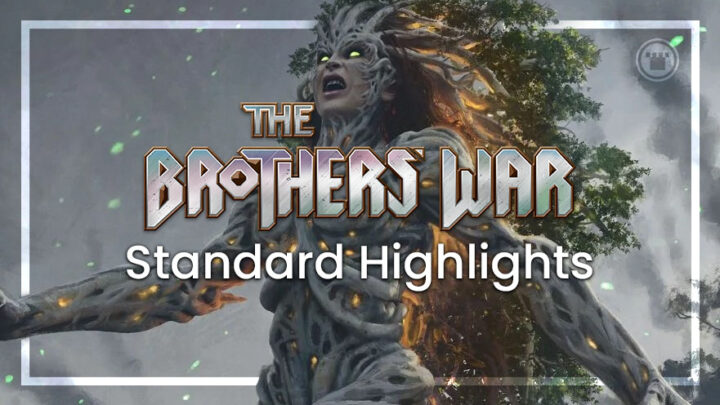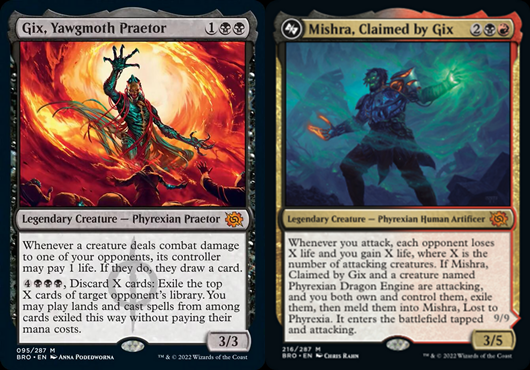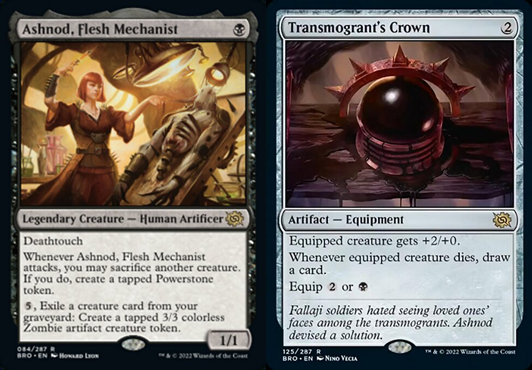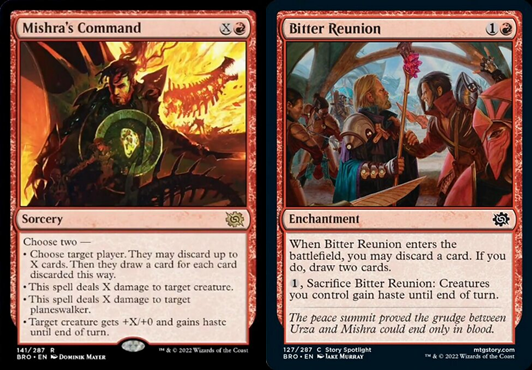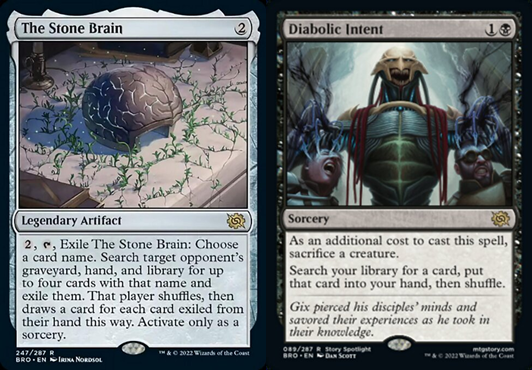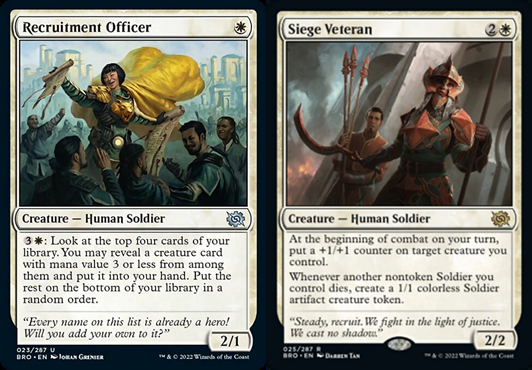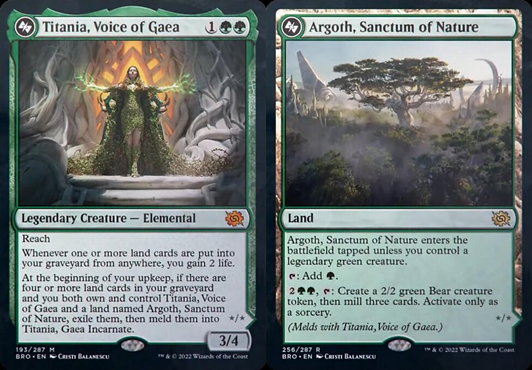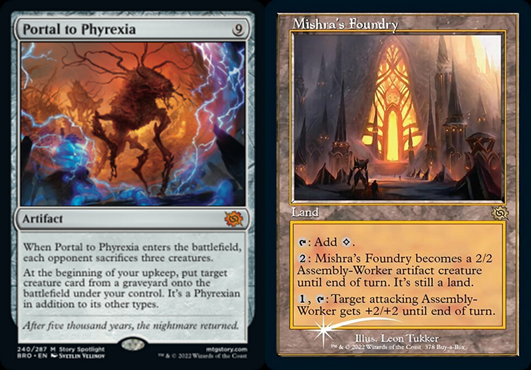It’s time for another Standard set preview season — but anticipating the reveal of The Brothers’ War has been a very different experience. Unlike most new sets, we already had a very good idea of the story, characters and setting. It’s essentially a remaster of the earliest Magic fiction. But at the same time, we had very little idea of what the actual card design for this set would look like.
While other “return to” sets usually follow their predecessor’s mechanical themes, the familiar characters and story beats from The Brothers’ War are pretty much the only recognizable aspects. The direct design homages are limited to just a couple of cards instead of going all in on artifacts, like Antiquities.
The end result is a set that seems right at home in 2022 Standard, and there’s already some strong early prospects for which of these powerful new cards will make their mark there first.
BROTHERLY LOVE
Blue control decks have been lacking since the last rotation, with Mono-Blue Delver and Esper Midrange taking the color in more of a tempo direction. But Urza and friends seem very well equipped to bring back that traditional blue/white playstyle, combining seamlessly with the various, slower Wandering Emperor White decks already in Standard.
Urza, Lord Protector is an obvious place to start, discounting all the non-creature (and non-planeswalker) spells you want in that kind of deck. It seems like the kind of legendary effect you just play one or two of — but one copy is all you need to threaten the dream curve of turn three Urza, turn four The Mightstone and Weakstone, turn five meld!
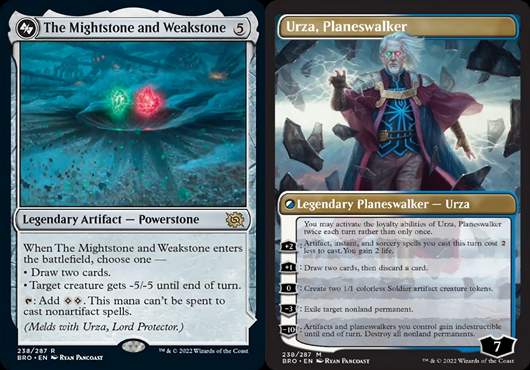
Both cards seem just solid enough in their own right that a slower deck could appreciate this kind of inevitability. However, Urza will be teaming up with a much more reliable planeswalker threat to keep control afloat: Teferi, Temporal Pilgrim.
Wizards still hasn’t made a bad Teferi card (Planeswalker decks don’t count), and this one looks to fill the top-of-curve spot for blue control as long as it’s legal. The Wandering Emperor will still be around, of course, but this is the true card advantage engine control players were waiting for.
I’m also hopeful for the Standard playability of The Temporal Anchor, particularly if we do see Urza and the artifact-only mana from Powerstones lead to a stronger artifact theme.
Even without those ramp effects, this costs just one more mana than Teferi himself, and it’s going to “draw” a ton of cards very quickly. There is a soft deck building requirement here, where The Temporal Anchor gets better the fewer reactive instants you play, but there should be enough lands, artifacts and creatures in this deck to take full advantage.
YOUNGEST CHILD SYNDROME
It only makes sense that Urza’s less-famous brother gets an equal amount of mechanical support, and Mishra’s side of the The Brothers’ War also seems ready for Standard competition right out the gate.
I’ve been itching to play Sheoldred, the Apocalypse and Evolved Sleeper in a more aggressive list, but the shallow, post-rotation card pool just couldn’t back them up. The Brothers’ War will definitely change that, adding the creature-based draw engines that are essential to playing aggro in 2022. Gix, Yawgmoth Praetor, Bladewhip Transmogrant and Ashnod, Flesh Machinist fill out the curve well.
Meanwhile Transmogrant’s Crown meets the high standard needed to play a non-attacking, non-interactive spell in aggro: synergizing well with all the cards just mentioned (in addition to Tenacious Underdog).
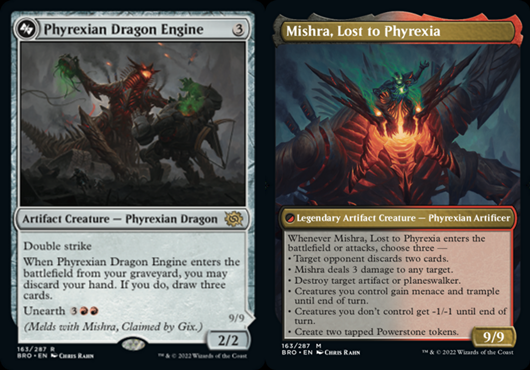
If you’re still not quite satisfied with what mono-black offers alone, you can add red for the Bloodtithe Harvester/Fable of the Mirror Breaker package. Those cards make it easy to filter your way to the deadly meld combination of Mishra, Claimed by Gix and Phyrexian Dragon Engine (the latter being an easy discard to your Fable triggers) and deliver an immediate killing blow.
PROTOTYPE POWER
Besides the obvious artifact themes, The Brothers War will add a ton of power to the various graveyard-themed decks hanging around Standard. Of those, I’m personally the most excited about Invoke Justice. It’s just so rare that the white member of a rare cycle is the strongest effect, but in Standard this super-reanimator sorcery arguably has Invoke Despair beaten.
I was a huge fan of the all-in, red/white build pre-rotation, but the loss of Velomachus Lorehold as the main target (plus several of the better discard enablers) made it hard to keep Invoke Justice as the lynchpin of the deck. Queen Kayla bin-Kroog, Bitter Reunion and Mishra’s Command give you the surplus of draw-filtering to all but guarantee a smooth curve into Invoke Justice.
I’m also excited to test out Skitterbeam Battalion and Combat Thresher in this deck, as Prototype is the ideal mechanic for a deck which wants to both curve out and have massive reanimation payoffs available at the same time.
With the addition of more painlands to Standard, we can even go into Mardu for Mishra, Tamer of Mak Fawa. This gives us another way to play with prototypes in our graveyard while making it difficult to interact with our giant, reanimated threats.
ISOLATED FINDINGS
Clearly The Brothers’ War has a lot of support for its major themes and the titular brothers themselves, but there are also some standout individual cards you should look out for:
It’s hard to say anything revolutionary about Monastery Swiftspear, but its presence can single-handedly boost mono-red to prominence.
The Stone Brain is less likely to be huge in Standard compared to its potential in combo-heavy Eternal formats, but it will still be a welcome and important sideboard option going forward. That said, the reprinted Diabolic Intent is the best tutor potential Standard combo decks have had for years.
White/X Soldiers seems like it has a critical mass of cards now, with Thalia, Brutal Cathar, Valiant Veteran, Siege Veteran, Guardian of New Benalia, Sungold Sentinel and Recruitment Officer in the format.
The only question is what color combination comes out the best: blue/white with Harbin, Vanguard Aviator? green/white with King Darien XLVIII? How about red/white with Baird, Argivian Recruiter alongside Yotian Frontliner? Or can Secluded Courtyard plus the painlands support some kind of rainbow coalition of them all?
Unlike Urza or Mishra, the new Titania Meld lacks an obvious home in the metagame. But there is a real depth of creatures to support an aggressive self-mill plan in Sultai: Deathbonnet Sprout, Willow Geist, Urborg Lhurgoyf, Vilespawn Spider, Old Stickfingers, Llanowar Greenwidow and Slogurk, the Overslime all play well.

DAYS OF FUTURE PAST
I haven’t even come close to touching on every card in The Brothers’ War, which will soon reshape Standard. The set is just as powerful as you’d expect from its legendary subject matter, and it’s arriving into a post-rotation format starving for new staple cards.
I say bring it on — nine-mana robots and gigantic melded planeswalkers are the perfect palate cleanser after generic value-monsters like Goldspan Dragon and Esika’s Chariot dominated the last few years. Aggro decks also seem like they’re finally ready to return, with new two-power one drops and the painlands rounding out their manabase.
We’ve reached my favorite part of a Standard season, with enough sets available to offer deck building opportunities without drowning out the power of single-set themes, like werewolves or enchantment creatures. I look forward to seeing you all In The Trenches!

Tom’s fate was sealed in 7th grade when his friend lent him a pile of commons to play Magic. He quickly picked up Boros and Orzhov decks in Ravnica block and has remained a staunch white magician ever since. A fan of all Constructed formats, he enjoys studying the history of the tournament meta. He specializes in midrange decks, especially Death & Taxes and Martyr Proc. One day, he swears he will win an MCQ with Evershrike. Ask him how at @AWanderingBard, or watch him stream Magic at twitch.tv/TheWanderingBard.

